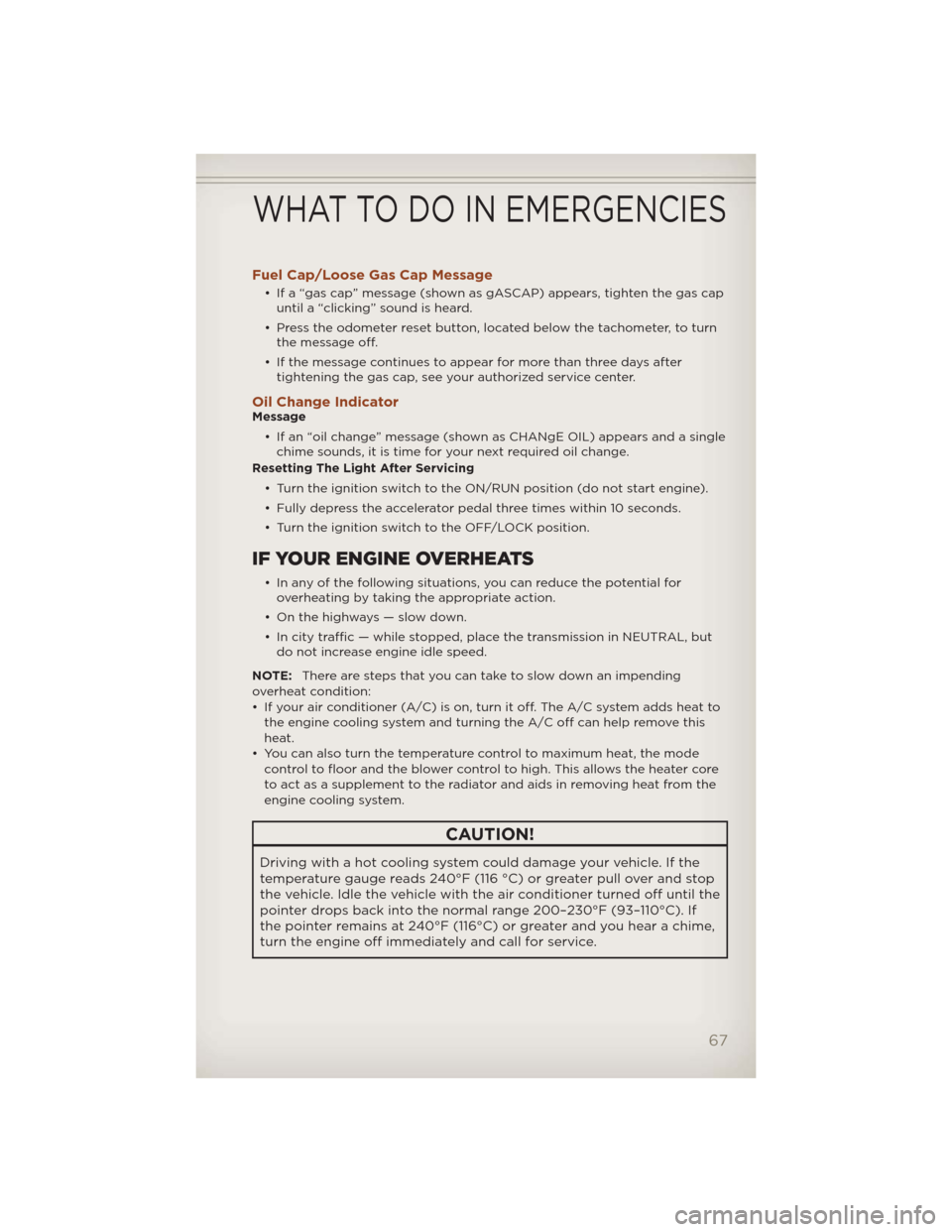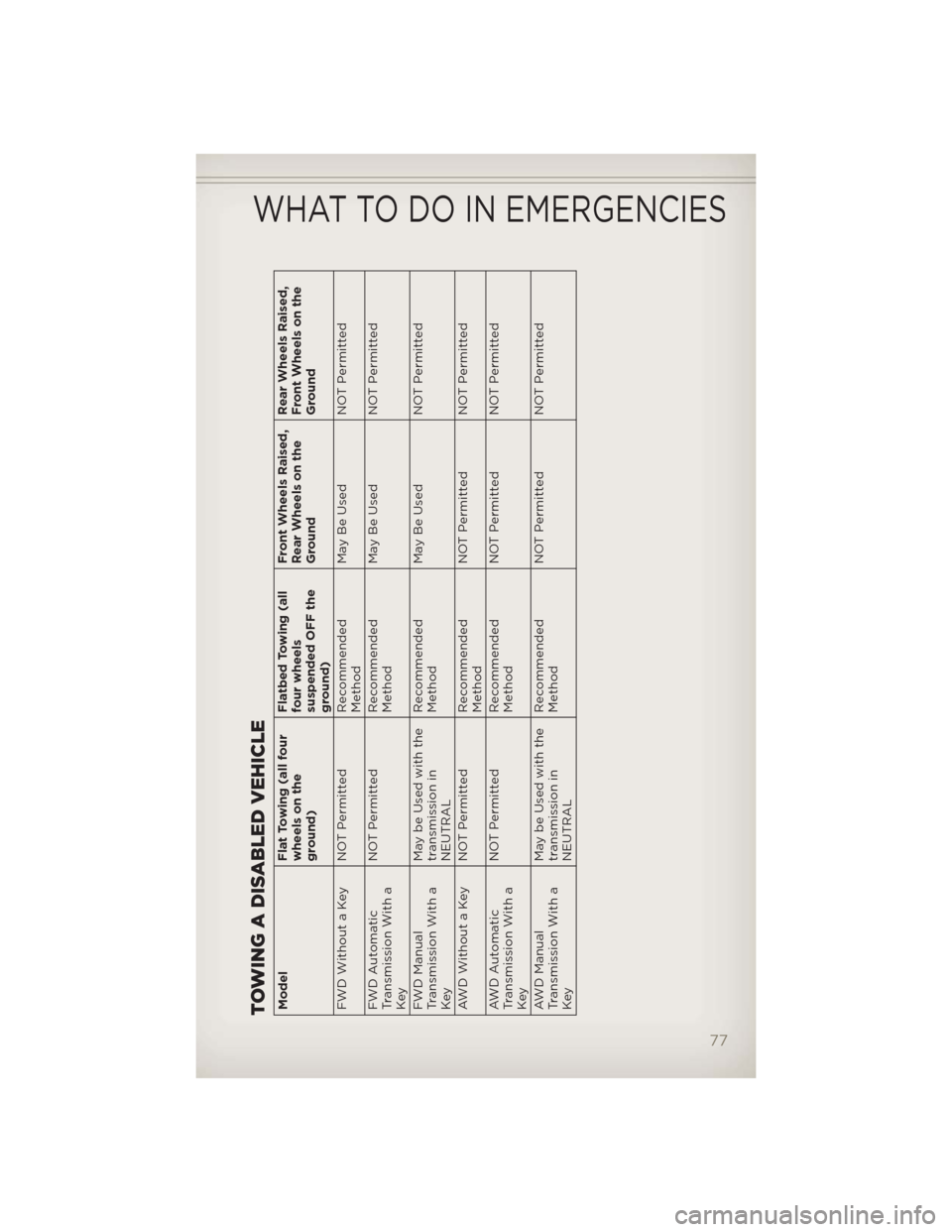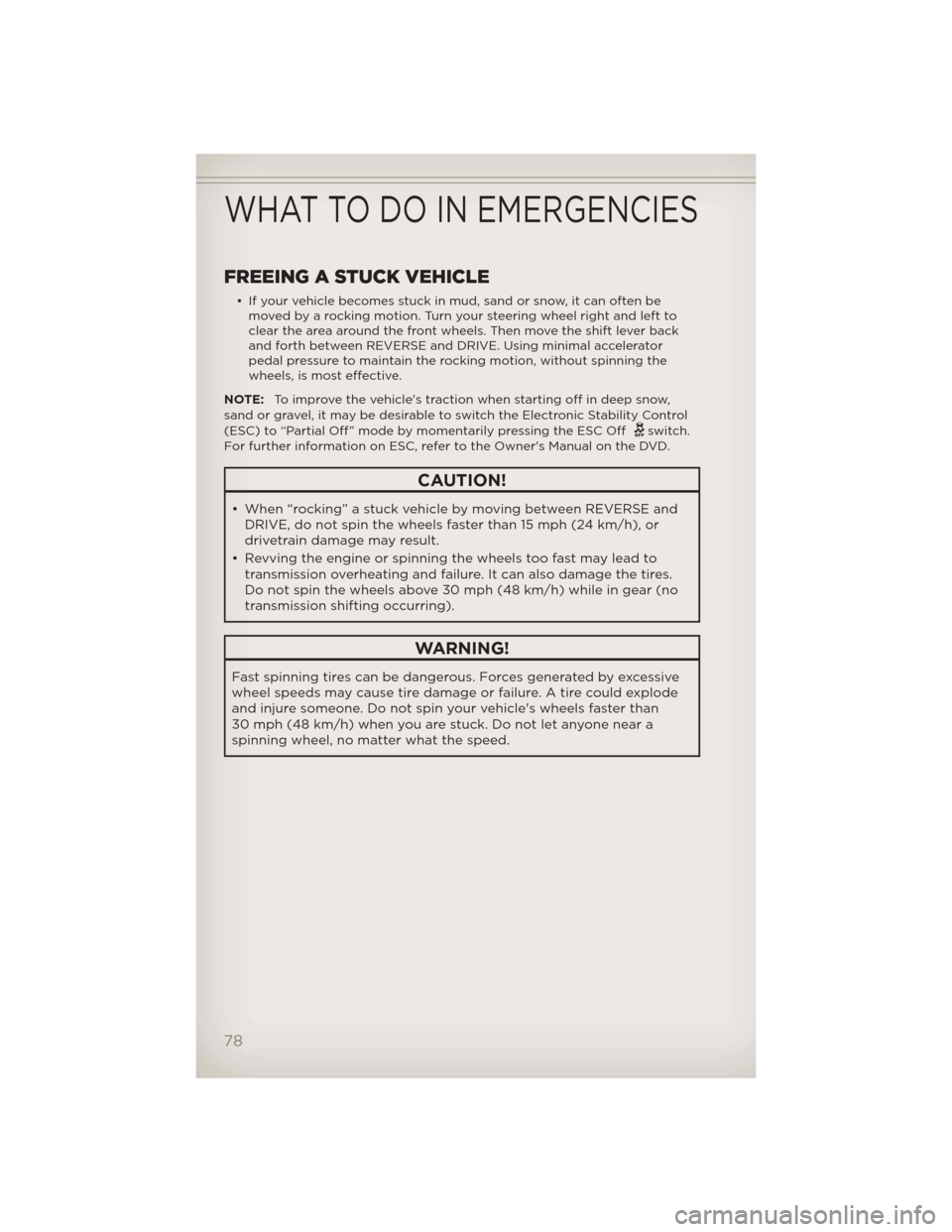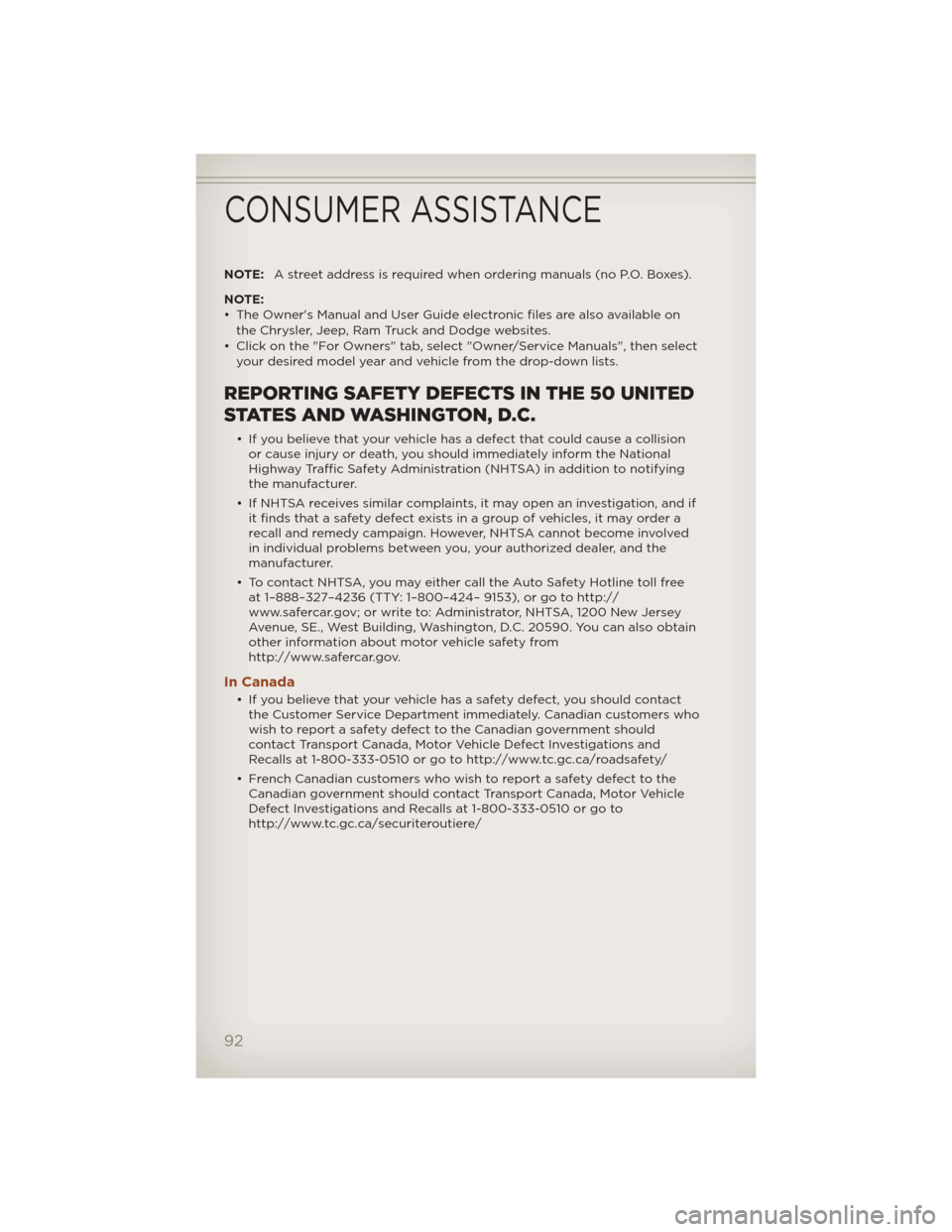ECO mode JEEP COMPASS 2012 1.G Owner's Manual
[x] Cancel search | Manufacturer: JEEP, Model Year: 2012, Model line: COMPASS, Model: JEEP COMPASS 2012 1.GPages: 108, PDF Size: 4.03 MB
Page 69 of 108

Fuel Cap/Loose Gas Cap Message
• If a “gas cap” message (shown as gASCAP) appears, tighten the gas cap
until a “clicking” sound is heard.
• Press the odometer reset button, located below the tachometer, to turn
the message off.
• If the message continues to appear for more than three days after
tightening the gas cap, see your authorized service center.
Oil Change IndicatorMessage
• If an “oil change” message (shown as CHANgE OIL) appears and a single
chime sounds, it is time for your next required oil change.
Resetting The Light After Servicing
• Turn the ignition switch to the ON/RUN position (do not start engine).
• Fully depress the accelerator pedal three times within 10 seconds.
• Turn the ignition switch to the OFF/LOCK position.
IF YOUR ENGINE OVERHEATS
• In any of the following situations, you can reduce the potential for
overheating by taking the appropriate action.
• On the highways — slow down.
• In city traffic — while stopped, place the transmission in NEUTRAL, but
do not increase engine idle speed.
NOTE:There are steps that you can take to slow down an impending
overheat condition:
• If your air conditioner (A/C) is on, turn it off. The A/C system adds heat to
the engine cooling system and turning the A/C off can help remove this
heat.
• You can also turn the temperature control to maximum heat, the mode
control to floor and the blower control to high. This allows the heater core
to act as a supplement to the radiator and aids in removing heat from the
engine cooling system.
CAUTION!
Driving with a hot cooling system could damage your vehicle. If the
temperature gauge reads 240°F (116 °C) or greater pull over and stop
the vehicle. Idle the vehicle with the air conditioner turned off until the
pointer drops back into the normal range 200–230°F (93–110°C). If
the pointer remains at 240°F (116°C) or greater and you hear a chime,
turn the engine off immediately and call for service.
WHAT TO DO IN EMERGENCIES
67
Page 79 of 108

TOWING A DISABLED VEHICLEModelFlat Towing (all four
wheels on the
ground)Flatbed Towing (all
four wheels
suspended OFF the
ground)Front Wheels Raised,
Rear Wheels on the
GroundRear Wheels Raised,
Front Wheels on the
Ground
FWD Without a Key NOT Permitted Recommended
MethodMay Be Used NOT Permitted
FWD Automatic
Transmission With a
KeyNOT Permitted Recommended
MethodMay Be Used NOT Permitted
FWD Manual
Transmission With a
KeyMay be Used with the
transmission in
NEUTRALRecommended
MethodMay Be Used NOT Permitted
AWD Without a Key NOT Permitted Recommended
MethodNOT Permitted NOT Permitted
AWD Automatic
Transmission With a
KeyNOT Permitted Recommended
MethodNOT Permitted NOT Permitted
AWD Manual
Transmission With a
KeyMay be Used with the
transmission in
NEUTRALRecommended
MethodNOT Permitted NOT Permitted
WHAT TO DO IN EMERGENCIES
77
Page 80 of 108

FREEING A STUCK VEHICLE
• If your vehicle becomes stuck in mud, sand or snow, it can often be
moved by a rocking motion. Turn your steering wheel right and left to
clear the area around the front wheels. Then move the shift lever back
and forth between REVERSE and DRIVE. Using minimal accelerator
pedal pressure to maintain the rocking motion, without spinning the
wheels, is most effective.
NOTE:To improve the vehicle's traction when starting off in deep snow,
sand or gravel, it may be desirable to switch the Electronic Stability Control
(ESC) to “Partial Off” mode by momentarily pressing the ESC Off
switch.
For further information on ESC, refer to the Owner's Manual on the DVD.
CAUTION!
• When “rocking” a stuck vehicle by moving between REVERSE and
DRIVE, do not spin the wheels faster than 15 mph (24 km/h), or
drivetrain damage may result.
• Revving the engine or spinning the wheels too fast may lead to
transmission overheating and failure. It can also damage the tires.
Do not spin the wheels above 30 mph (48 km/h) while in gear (no
transmission shifting occurring).
WARNING!
Fast spinning tires can be dangerous. Forces generated by excessive
wheel speeds may cause tire damage or failure. A tire could explode
and injure someone. Do not spin your vehicle's wheels faster than
30 mph (48 km/h) when you are stuck. Do not let anyone near a
spinning wheel, no matter what the speed.
WHAT TO DO IN EMERGENCIES
78
Page 94 of 108

NOTE:A street address is required when ordering manuals (no P.O. Boxes).
NOTE:
• The Owner's Manual and User Guide electronic files are also available on
the Chrysler, Jeep, Ram Truck and Dodge websites.
• Click on the "For Owners" tab, select "Owner/Service Manuals", then select
your desired model year and vehicle from the drop-down lists.
REPORTING SAFETY DEFECTS IN THE 50 UNITED
STATES AND WASHINGTON, D.C.
• If you believe that your vehicle has a defect that could cause a collision
or cause injury or death, you should immediately inform the National
Highway Traffic Safety Administration (NHTSA) in addition to notifying
the manufacturer.
• If NHTSA receives similar complaints, it may open an investigation, and if
it finds that a safety defect exists in a group of vehicles, it may order a
recall and remedy campaign. However, NHTSAcannot become involved
in individual problems between you, your authorized dealer, and the
manufacturer.
• To contact NHTSA, you may either call the Auto Safety Hotline toll free
at 1–888–327–4236 (TTY: 1–800–424– 9153), or go to http://
www.safercar.gov; or write to: Administrator, NHTSA, 1200 New Jersey
Avenue, SE., West Building, Washington, D.C. 20590. You can also obtain
other information about motor vehicle safety from
http://www.safercar.gov.
In Canada
• If you believe that your vehicle has a safety defect, you should contact
the Customer Service Department immediately. Canadian customers who
wish to report a safety defect to the Canadian government should
contact Transport Canada, Motor Vehicle Defect Investigations and
Recalls at 1-800-333-0510 or go to http://www.tc.gc.ca/roadsafety/
• French Canadian customers who wish to report a safety defect to the
Canadian government should contact Transport Canada, Motor Vehicle
Defect Investigations and Recalls at 1-800-333-0510 or go to
http://www.tc.gc.ca/securiteroutiere/
CONSUMER ASSISTANCE
92